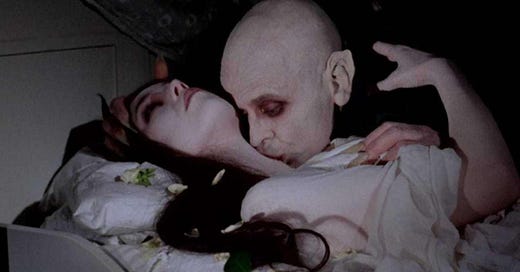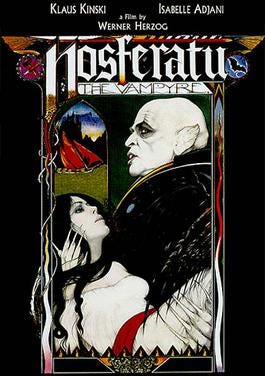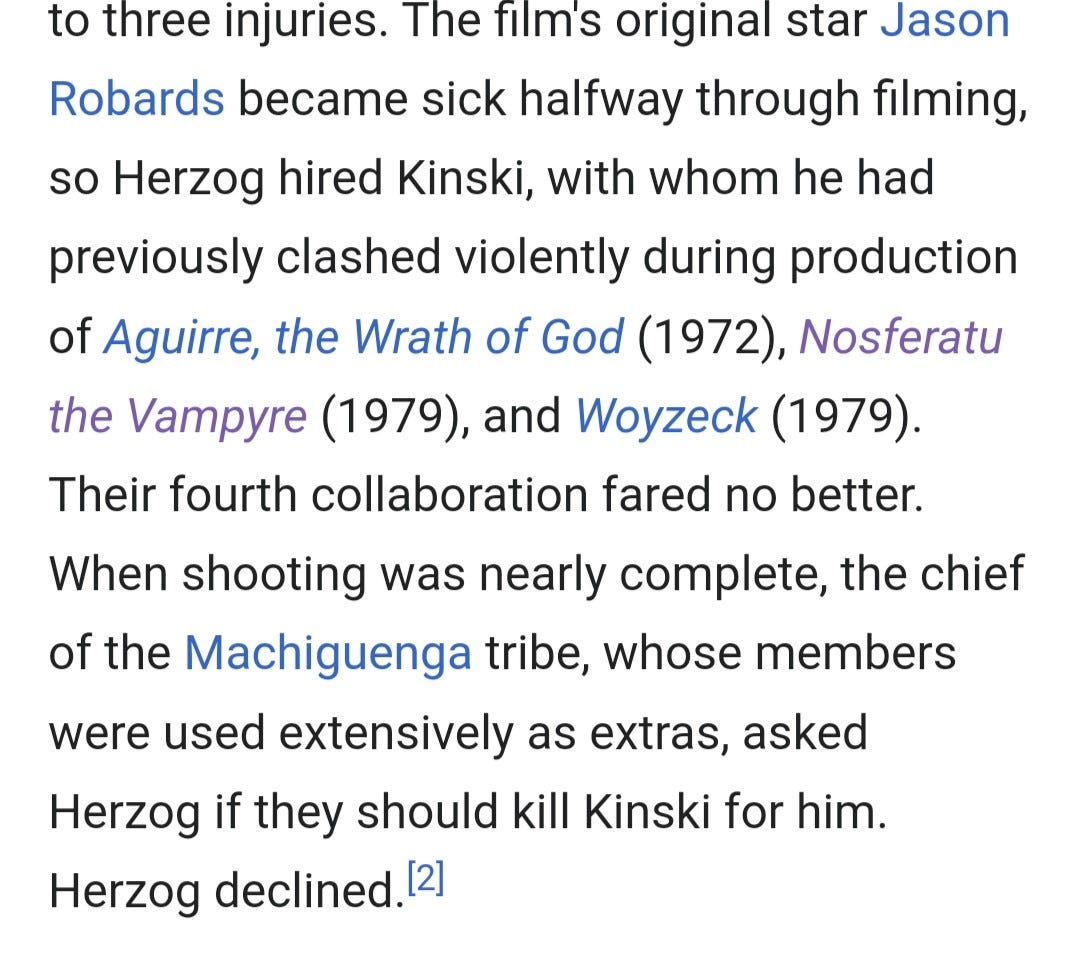BAT!
*the bat says: “spoilers from the jump, as per usual”
Nosferatu the Vampyre
Directed by: Werner Herzog
Based on: Bram Stoker’s Dracula, F.W. Murnau’s Nosferatu – Eine Symphonie des Grauens
Starring: Klaus Kinsi, Isabelle Adjani, Bruno Ganz, Roland Topor
Run time: 107 minutes
Original release date: 17 January 1979
i present to you a conundrum
How many ways can you adapt one story to screen and still bring something new to it? Bram Stoker’s 1897 novel Dracula has been the basis in some way or another for so many adaptations that “Count Dracula in popular culture” is its own separate Wikipedia page. Nosferatu the Vampyre isn’t even the only adaptation that came out in 1979 (John Badham’s Dracula, with Frank Langella as The Count also came out that year). It’s a story that people keep wanting to come back to - for example, look at how popular Matt Kirkland’s Dracula Daily is every year (ART).
And I’m not here to dissect why people keep being drawn to Dracula; some stories and characters are just eternal. But Dracula is also a malleable story. One that you can take elements from and remix, rewire and adapt to something new, or in the case of New German Cinema pioneer (and owner of one of the world’s greatest accents) Werner Herzog, something completely your own.
the Kinski issue
Herzog, a multi-hyphenate film maker (aside from narrative films, you maybe know him from his documentaries - I first heard his name when 2005’s Grizzly Man came out) and some time actor (you may have seen him as The Client in The Mandalorian, he of “I would like to see the baby”) is difficult to sum up (…. as demonstrated just now). A creator who seems to see movies on a whole different level, listening to Herzog talk about film making and storytelling feels a lot like he’s playing 4D chess while the rest of us are playing Jenga. At the point of making Nosferatu the Vampyre, he was already several films and documentaries into his career, not to mention he’d already put out a hell of a calling card as a narrative film maker with 1972’s Aguirre, the Wrath of God. Here was a man fascinated by the ends of the earth, unafraid by the darkness of madness.
And what is Dracula if not a story about the darkness of the madness of love?
Herzog did however not seek to make an adaptation of Dracula; what he wanted was to pay homage to what he considered the greatest film to ever come out of Germany: Nosferatu. The crucial difference between Herzog’s film and Murnau’s is that Herzog deliberately waited until the day Dracula’s copyright entered the public domain to make his version, so that he could use the original’s character names in his updated version.
Also, and even more crucial, Herzog had in mind for his Dracula a man with whom he had a history which can best be described as “it’s complicated”: Klaus Kinski. Kinski had years prior rented a room in Herzog’s family apartment and, to put it mildly, spent the entire three months he lived there scaring the ever-loving shit out of Herzog and his family. Those three months left a lasting impression on Herzog (again, to put it mildly) and when it came time to cast the lead for Aguirre, he sent Kinski the script and got in return an incoherent middle-of-the-night phone call which ended in Kinski accepting the role.
They then fought the entire shoot.
The problem here is that when Kinski was on, he was kind of mesmerizing to watch and while Herzog frequently was on the verge of actually k-wording him, he clearly also valued him as a performer, to his own detriment as this extract from the Wikipedia page of Fitzcarraldo shows.
Time is an abyss
Nosferatu the Vampyre is a movie of quiet dread. The film (after one of the most haunting opening credit sequences I’ve ever seen) starts with Lucy (Isabella Adjani, two years before her role in Possession and looking like the most ethereal goddess, seriously her hair is so shiny) waking up from a nightmare. We get a few very dreamy, wistful scenes of Lucy and her husband Jonathan Harker (Bruno Ganz) taking walks around Wismar, Germany (here played by the city of Delft, The Netherlands, AND QUITE OBVIOUSLY SO) and playing with their two tiny kittens as Lucy expresses that she feels something bad on the horizon. Jonathan, an estate agent, attends his office and his employer, Renfield (Roland Topor, the film’s undisputed winner of the Doing The Most olympics) informs him that a nobleman by the name of Count Dracula (Kinski, natch) is in the market for a property in Wismar.
I should point out that Topor as Renfield, in one of the movie’s most delightful acting choices, decides to punctuate most of his lines with a giggle so unhinged it’s a wonder Jonathan didn’t quit his job on the spot. Instead, he takes on the job and to Lucy’s dismay, travels to Dracula’s castle in Transylvania, a four week journey in which a variety of characters tell him to stay the fuck away from Count Dracula (the innkeeper’s wife coming into his room to splash him with holy water is hilarious). Again, Jonathan does not heed warnings - even after the coach rider rejects his request to take him via the Borgo Pass (he basically denies he even owns a coach or horses while standing directly next to his coach and horses, that’s how much he’s unwilling to take him) - and travels the rest of the way on foot. Herzog’s camera really shines here, reveling in shots of eerie oncoming darkness and mist, suggesting without words that the castle he is traveling to may not even exist.
Nevertheless, Jonathan arrives at the castle, and is greeted by the Count Dracula, his bright white face a puncturing of the inky black night. Again, Herzog has a brilliant eye for shot composition - both the shots of Jonathan being greeted by the Count and the shot of them at the table with the plans of the house in Wismar are among my favourite in any horror film.
Kinski as the Count is melancholy, pathetic (there’s moments where he’s just making these weird mewling noises) and weary of his situation. Roger Ebert called it a performance without ego and I definitely see it because Kinski embodies Dracula with an intensity only he can give it but also with a suggestion that he thinks very highly of this role entrusted to him. The Count is apprehensive about the plans until he by chance spies a small portrait of Lucy in a medallion Jonathan is wearing (“what a lovely neck”) and agrees immediately. Jonathan, during his stay in the castle, is haunted at night by the Count’s presence, increasingly believing something is very off about him.
Meanwhile, Lucy is plagued by ongoing nightmares of impending doom and, just, like a lot of bats. It’s suggested she and Jonathan share a sort of psychic link, because when she wakes up screaming to the alarm of Doctor Van Helsing (Walter Ladengast) and Mina (Martje Grohmann) - who are staying with her in Jonathan’s abscence - she can feel a sharp pain in her neck, just as Jonathan is seemingly bitten by the Count. (Isabelle Adjani’s blood curdling scream of JONATHAN is one for the ages).
Jonathan wakes up, as if from a nightmare (there’s a suggestion that the Count has been sneaking in for a bit of a drink during the night) and goes on a quest in the castle trying to figure out why the Count is never seen during the day. Needless to say, when he discovers the answer (he is, of course, busy being asleep in his coffin full of earth and rats) he is determined to get the absolute fuck out of there.
*back in Wismar, at this point, Renfield, now fully insane has been committed to an asylum after being caught biting a cow. Roland Topor continues doing The Most. It’s great.
Jonathan finds himself trapped in the castle, however, watching in horror as Dracula leaves for Wismar, cursed earth-filled coffins in tow. He tries to escape but falls to the ground out of a window, severely injured - he wakes the next morning, stirred by the sound of a young Romani boy playing the violin (it is not the first time the boy appears and also he may be a ghost), and eventually finds himself in a hospital, baffling the doctors with talk of black coffins.
death comes to Wismar
Speaking of those black coffins, they're making their way to Wismar via ship (it’s not named as the Demeter but by all accounts that’s what it is), a ship which is being terrorized at night by the count. When it finally arrives in Wismar, sailing slowly into the heart of the city via the canals, it arrives with no crew and the captain dead and tied to the helm. Doctors find a ship log indicating that it was the plague that killed the crew, but at night the Count rises (dragging the coffins full of earth from the ship, absolutely stunning scene because the man looks about as stable as a jelly pudding, how the hell is he dragging those coffins off the ship?) and soon plague and madness spreads through Wismar. And rats. So many fucking rats.
It’s at this point Jonathan materializes back home, ill and unable to recognize Lucy, much to her dismay. The Count visits Lucy at night (another great shot from Herzog, as we seem him through Lucy’s mirror - that’s to say we don’t see him at all as he’s got no reflection) and, weary and lonely, he demands she loves him like she loves Jonathan, which she refuses.
*meanwhile, there is an inconsequential but deeply funny scene of Renfield re-uniting with Dracula, who through body language alone basically indicates that he’d rather be absolutely nowhere near him. Dracula sends him to Riga and he is never seen again but probably still giggling his tits off all the way down the Via Baltica.
Determined to stop him, Lucy tries to convince the remaining population of Wismar that it’s not the plague that’s killing people, but as she drifts through the near empty city, she comes across a bizarre last supper/danse macabre tableau which (again) is shot beautifully, as if a haze has descended upon the city. As with most of the film, it’s strange and dreamy, like the city is embracing its death. Desperate, with a deteriorating Jonathan sitting in a corner of the living room, Lucy finds a possible solution in the book that was given to Jonathan by one of the Transylvanian people: Dracula can be defeated, if she distracts him long enough to forget the crowing of the cockerel signaling the break of dawn. She seemingly makes her peace with the fact that this will come at the cost of her own life, and in preparation traps Jonathan in his corner by crumbling communion wafers in a circle around his chair. She lays herself out on the bed, prepared for Dracula, and in the film’s sexiest scene, he attends her bedside and bites.
a case of the fumbled bag
As the first light of day shines into the bedroom, the Count sinks into a ball on the floor, whimpering as he dies. Van Helsing finds Lucy, dead but victorious, and decides to stake the Count through the heart to make sure that he stays properly dead and Lucy did not die in vain.
Unfortunately, this is where the movie loses me a little bit because there then follows a scene from a completely different movie - Carry On Nosferatu perhaps - in which Jonathan (suddenly quite vibrant) convinces the police to arrest Van Helsing (it is however very funny when the clerk asked to arrest him basically goes “there’s fuck all people left in the town, what do you want me to do?”) before telling one of the maids to wipe away “the dust” that surrounds his chair. He does a little comedy hop outside the circle of communion wafer bits and then declares that he has much to do - the film ends on a scene of him riding off into the distance, heavily implying that 1) he’s now a vampire and 2) he may actually have taken the spirit of Count Dracula into him.
None of this is necessary. You can just end the movie on Lucy being triumphant. It’s basically how the original Nosferatu ends. You don’t need to insert a little skit into your otherwise very good, melancholy take on a horror classic because it was *THIS* close to sticking the landing before it.
Nevertheless, it’s evidence that you can take a familiar story and work with how you key into the text to create something new. This movie could only be made by Werner Herzog - a man who thrives in exploring the blurs between dream and madness. This Dracula could only be played by Klaus Kinski - a man who was by all accounts deeply not healthy in his head (nor a good person in his life off screen - his daughters Pola and Nastassja have both come out with stories of sexual abuse which, fucking hell) but committed to his roles with an intensity that is uniquely him. The story may be familiar, but the dream is entirely Herzog.
Hashtag BESTIES!!!






